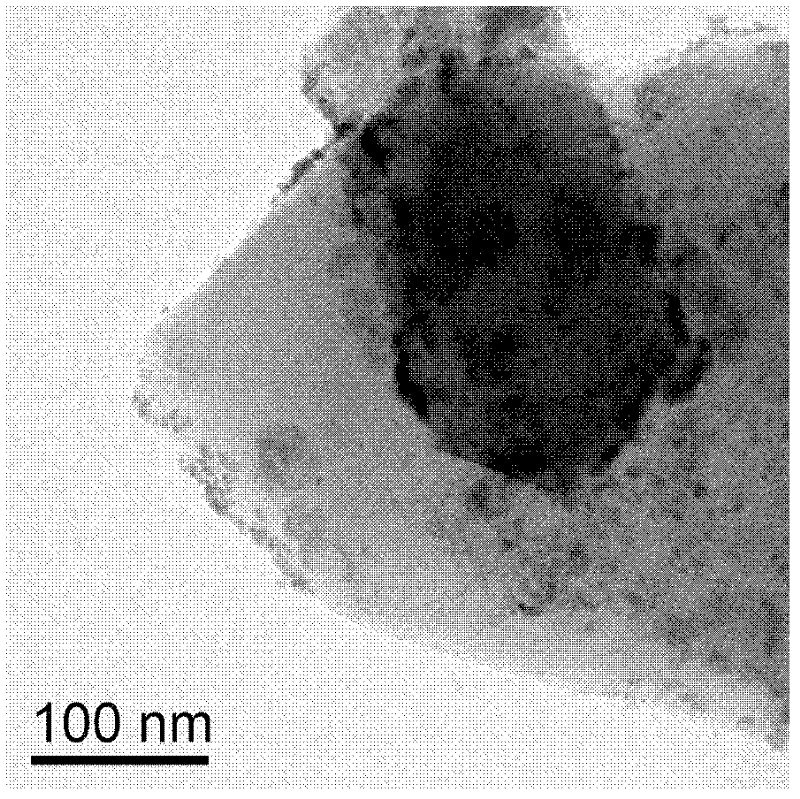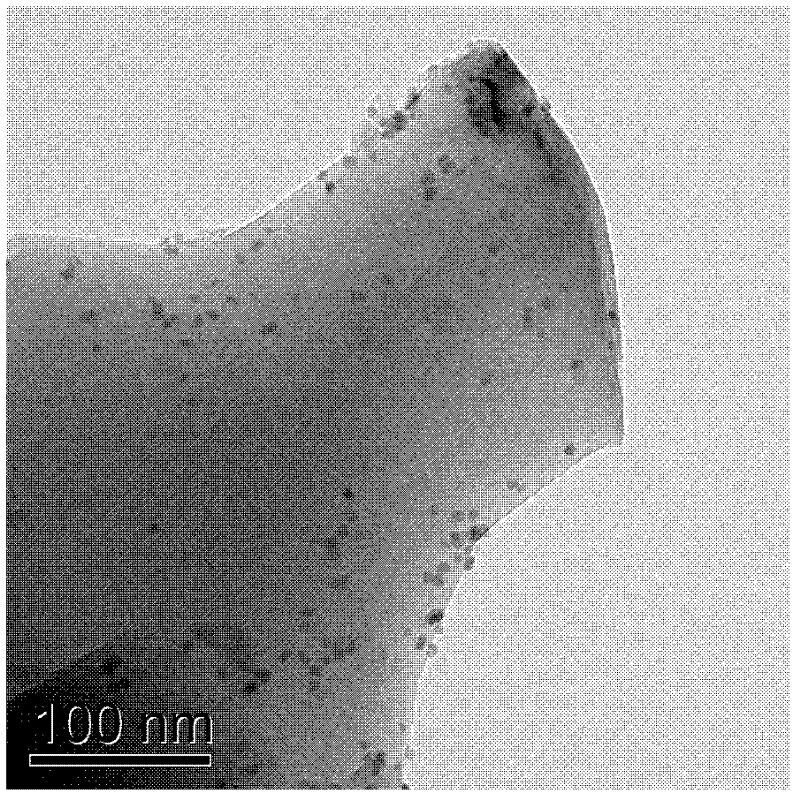Preparation method of high-dispersity supported nano metal catalyst
A nano metal and catalyst technology is applied in the field of preparation of highly dispersed supported nano precious metal catalysts, which can solve the problems of inability to control the size and morphology of metal particles, and it is difficult to obtain highly dispersed and long-life catalysts.
- Summary
- Abstract
- Description
- Claims
- Application Information
AI Technical Summary
Problems solved by technology
Method used
Image
Examples
Embodiment 1
[0039] Embodiment 1: Preparation of 2% Pd / Al 2 o 3 nanocatalyst
[0040] Weigh 1g of alumina and impregnate it into 5mL of 37.6mmol / L Pd(NO 3 ) 2- In the aqueous solution, stir for 3 hours, ultrasonically disperse in a 40°C water bath with 250W energy for 4 hours, dry at 110°C for 4 hours, bake at 350°C for 4 hours, add 0.070g ascorbic acid, 0.353g KBr, 0.444g PVP, and reduce at 100°C for 30 minutes, washed three times with water and ethanol, and dried under vacuum at 60°C for 10 hours. TEM photo see figure 1 , it can be seen from the figure that Pd is evenly dispersed on the surface of the carrier, and the particles are mainly spherical, with a small amount of irregular polyhedron, and the average size is 4–5 nm. High-resolution transmission electron microscope photos see figure 2 , it can be seen from the figure that the main exposed crystal plane of Pd is (111) plane.
Embodiment 2
[0041] Embodiment 2: Preparation of 1% Pd / Al 2 o 3 nanocatalyst
[0042] Weigh 1g of alumina and impregnate it into 2.5mL of 37.6mmol / L Pd(NO 3 ) 2- Add 2.5mL ethanol to the aqueous solution, stir for 3 hours, ultrasonically disperse in a 40°C water bath with 250W energy for 4 hours, dry at 110°C for 4 hours, and roast at 350°C for 4 hours, add 0.105g citric acid, 0.353g KBr, 0.523 g P123, reduced at 90°C for 15 hours, then added 0.018g of ascorbic acid to continue the reduction at 90°C for 30 minutes, washed with water and ethanol three times, and dried in vacuum at 60°C for 10 hours. TEM photo see image 3 , it can be seen from the figure that Pd is evenly dispersed on the surface of the carrier, and the particles are mainly spherical, with a small amount of irregular polyhedrons, and the average size is 4–6 nm. High-resolution transmission electron microscope photos see Figure 4 , it can be seen from the figure that the main exposed crystal plane of Pd is (111) plane...
Embodiment 3
[0043] Embodiment 3: Preparation of 0.5% Pd / Al 2 o 3 nanocatalyst
[0044] Weigh 1g of alumina and impregnate it into 1.25mL of 37.6mmol / L Pd(OAc) 2- Add 4 mL of acetone to the acetone solution, stir for 3 hours, ultrasonically disperse in a 35°C water bath with 200W energy for 4 hours, dry at 110°C for 4 hours, and roast at 400°C for 2 hours, add 1mL of 0.4mol / L potassium borohydride solution, 0.353 g KBr, 0.444g PVP, reduced at 100°C for 30 minutes, washed with water and ethanol three times, and dried under vacuum at 60°C for 10 hours. TEM photo see Figure 5 , it can be seen from the figure that Pd is evenly dispersed on the surface of the carrier, and the particles are mainly spherical, with a small amount of irregular polyhedron, and the average size is 3–5 nm.
PUM
| Property | Measurement | Unit |
|---|---|---|
| size | aaaaa | aaaaa |
| size | aaaaa | aaaaa |
| size | aaaaa | aaaaa |
Abstract
Description
Claims
Application Information
 Login to View More
Login to View More - R&D
- Intellectual Property
- Life Sciences
- Materials
- Tech Scout
- Unparalleled Data Quality
- Higher Quality Content
- 60% Fewer Hallucinations
Browse by: Latest US Patents, China's latest patents, Technical Efficacy Thesaurus, Application Domain, Technology Topic, Popular Technical Reports.
© 2025 PatSnap. All rights reserved.Legal|Privacy policy|Modern Slavery Act Transparency Statement|Sitemap|About US| Contact US: help@patsnap.com



